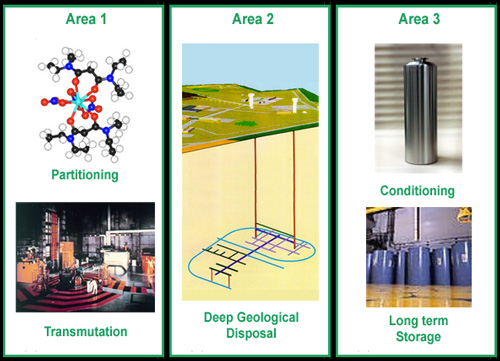Research and development on radioactive waste
When the quantity of radioactive waste was quite small, very basic solutions was used for its disposal, such as immersing radioactive packages in the sea. Dilution and time would lessen the effects of the radioactivity. However, as the volume of high-level waste increased, that solution had to be abandoned. At the same time, concern about the environment also grew, and the mechanisms involved in passing radioactivity up the food chain were taken into account. A large amount of effort was made to prevent any human contact with radioactivity. There is no doubt that nuclear is the industry that has taken more care of its waste than any other. The level of containment of radioactivity now achieved probably provides sufficient protection for the waste produced to date.
However, despite the progress made, the final fate of the most radioactive waste still has to be decided. What will be done with it if nuclear has to be abandoned, or indeed what will be done with it if nuclear is expanded? Because of the fears of an ill-informed public, governments have put off making decisions, with all the risks of paralysis and lack of comprehension that entails.
Efforts have been made in many countries to improve the processing of waste, and especially to decide what will be done with the most highly radioactive waste. Research in France was initially organised within the framework of the Bataille Act of 31 December 1991. This research is grouped into three main areas. France is very active in this field and is often used as a model.

Three research areas
The three research areas defined by the 1991 Bataille Act aim to solve the radioactive waste issues for which solutions have still not been found and to offer an array of management methods. The three areas are complementary. The first is engaged in exploring the potential for separating and destroying certain radioactive atoms, and the second is looking at the deep geological disposal of high-level waste, which will be inevitable. The third is aiming to improve the conditioning of waste and to enable it to be stored for long periods of time.
© IN2P3
Area 1 covers separation and transmutation: how to isolate certain radioactive bodies and how to use nuclear reactions to transform them and reduce or eliminate their radioactivity.
Area 2 covers the disposal of high-level long-lived waste: finding and studying the behaviour of deep geological strata that could accommodate this waste in complete safety.
Area 3 covers conditioning and storage: how to improve the immobilisation of radioactive atoms, and how to extend over long periods of time (up to 300 years) the storage used for this waste today.
Under the Bataille Act, an evaluation had to be carried out in 2006 of all the research undertaken. In 2006, a pivotal year, the scientific conclusions were presented to Parliament, which passed a new law. The main new provision of the 2006 Act was the decision in principle to build a disposal facility for nuclear waste in deep geological strata. This decision is where the CIGEO disposal facility project originated. It was to be built in the clay of the Paris Basin, close to the Bure laboratory on the boundary between the départements of Meuse and Haute-Marne. The construction of this facility is yet to be approved by Parliament.
Japan is another major nuclear power that has passed similar legislation. In 2001, based on the conclusions of a scientific report, the Japanese Parliament authorised the construction of an underground disposal site for high-level long-lived waste, to the north of Tokyo. The construction of the first major disposal site in the US, where the irradiated fuel from 106 reactors is stored in pools, will never be realised after the Yucca Mountain project was abandoned in 2009. In Europe, Sweden, which has already built an underground storage facility for spent fuel, could be the first country to have a disposal facility.
Articles on the subject « Waste Outlooks »
Area 1: Partitioning
Sorting the radioelements in radioactive waste The separation, or partitioning, of the radioactiv[...]
Partitioning: results
Development of processes and extractant molecules The 2006 assessment of research into partitioni[...]
Advanced partitioning
Partitioning of nuclear waste: hot chemistry Advanced partitioning goes beyond just the partition[...]
Area 1: Transmutation
Area 1: Transmuting or transforming radioactive atoms Transmutation is the second part of researc[...]
Transmutation facilities
Fast reactors and Accelerator Driven Systems (ADS) The neutron, which easily penetrates nuclei, i[...]
Transmutation prospects
A far away objective for Generation IV and 2040… At the time of the first tests on the tran[...]
Area 2: Disposal
Research into deep geological disposal Can the nuclear industry’s final waste, which we cur[...]
Area 3: Long Surface Storage
Research into long-term storage Research into long-term storage is the second research topic in a[...]
Long surface storage concepts
Long-term surface and subsurface storage Research into very long-term storage is a matter for the[...]
Area 3: Conditioning
Area 3: Research into conditioning The conditioning of high-level and intermediate-level waste is[...]